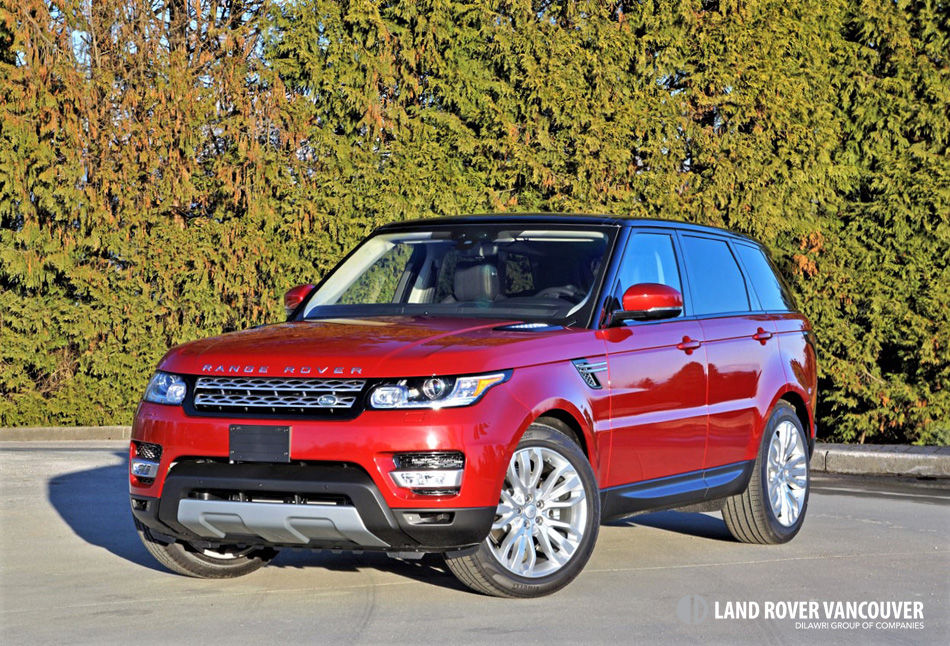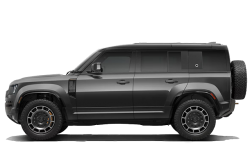2017 Land Rover Range Rover Sport HSE TD6 Road Test Review
June 15 2018, Land Rover Vancouver

TRULY DESERVING OF ITS LOFTY PRICE AND RESPECTFUL OF ITS REVERED PEDIGREE
There is premium and then there’s premium, if you know what I mean. Yes, even within the premium auto sector there are different levels of respectability, and Range Rover occupies the highest echelon of SUV culture. Still, it’s one of the better selling mid-size luxury SUVs available.
The Range Rover Sport’s success highlights an important point: value doesn’t merely equate to price. Rather, standard features, performance, refinement, style, and, of course, brand cachet can even be more important in luxury leagues. I certainly don’t need to educate anyone on Range Rover’s appeal in the luxury market, as it’s a legendary name that has few if any peers, and as for how it looks, a person really needs to be anti-style not to like this handsome SUV. Since its predecessor’s chunky lines were smoothed out as part of a complete second-generation redesign for the 2014 model year, which smartly pulled together traditionally upright Range Rover elements with a more performance-oriented sweptback look, and then combined them with artful detailing both outside and within, the Sport’s been the who’s who SUV to beat. One thing’s for sure, whether showing up at the club, to a dinner party, or an off-road terrain course, nobody’s going to laugh at you.
REFINEMENT THAT’S UNSURPASSED IN THE MID-SIZE LUXURY SUV CLASS
The Range Rover Sport’s cabin is one of the nicest in its mid-size luxury SUV class. Of course, it’s not as upscale as the larger Range Rover, but that’s in an entirely different class and priced accordingly. Just the same, only the best leathers get used in the Sport, and the metals are genuine, this model getting beautifully textured titanium-coloured surfacing where most noticeable, plus lighter-toned satin-finish aluminum highlighting key areas throughout the rest of the interior.
All of the Sport’s switchgear remains some of the industry’s best too, formed from high-quality composites and metals, tight fitting and nicely damped. Its electronic interfaces are superb as well, the primary gauges purely digital with a nice bright configurable display with crisp, clear graphics, a handy multi-information screen in the middle, and over on the centre stack an even more colourful array of infotainment features organized within a large and wide 10.2-inch touchscreen.
That central display is now standard for 2017, along with its InControl TouchPro infotainment interface and various InControl features such as Apps, Remote Premium, Remote Pro Services, and Protect, while this improvement also includes a larger rearview camera with active guidelines, upgraded navigation, Wi-Fi, and more. Of note, even the upgraded HSE model I tested last year was fitted with the old 8.0-inch touchscreen that was nowhere near as advanced looking or fully capable (the 10.2-inch system was optional), making this a major improvement to “lower end” trims, if there is such a thing with a Range Rover. On that note, additional new standard SE features include auto high beams, 14-way front seats with memory, autonomous emergency braking, and lane departure warning, these previously only available as upgrades.
NO SHORTAGE OF STANDARD FEATURES
There’s a price to pay for all the Sport SE enhancements, of course, but it’s a small one at just $1,010 over last year’s $75,990 base window sticker, while everything else that was part of the entry level package continues forward for 2017, including auto on/off HID headlamps with signature LEDs, heatable power-folding and auto-dimming side mirrors, proximity-sensing keyless entry, a powered gesture liftgate, pushbutton ignition, auto start/stop, an electromechanical parking brake, LED interior mood lighting, a full-colour five-inch TFT instrument cluster, rain-sensing wipers, 250-watt eight-speaker audio, Bluetooth phone and audio streaming, satellite radio, dual-zone auto climate control, a power-adjustable leather-wrapped heatable steering wheel, heated front and rear outboard seats, front and rear parking sensors with a visual display, a fixed panoramic sunroof (alternatively you can order your Sport without the sunroof, albeit with no discount, or upgrade to a powered one), all the usual active and passive safety features, and much more.
HSE trim adds $5,500 to the bottom line for an $82,500 MSRP, its features including one-inch larger 20-inch twinned five-spoke alloys, aluminum-look exterior trim detailing, LED fog lamps, a power-sliding panoramic sunroof (again you can opt for an all-metal roof instead), heavy-duty branded aluminum tread plates, Micro Mesh aluminum trim instead of Dark Satin Brushed aluminum, perforated Oxford leather upholstery in place of grained leather, and a universal HomeLink garage door opener.
My test model included a set of $1,800 21-inch alloys (that will cost you $3,000 with the base model), $850 Firenze Red metallic paint (there are 19 new exterior colours including various $4,500 Ultra Metallic paints in gloss or satin matte, and $9,500 ChromaFlair and pearlcoat colours in gloss or satin matte, totaling 37 colour choices, which makes it downright bizarre that my 2017 test model was finished an the identical hue as last year’s, minus the black roof), plus a $650 black painted pillars and rooftop, while my tester’s Td6 turbo-diesel engine was a very reasonable $2,000 more resulting in an $84,500 list price before additional options; the diesel, incidentally, only available in HSE trim.
OUR TESTER’S BEVY OF OPTIONS ENHANCED STYLE AND PERFORMANCE
Options included the $1,650 Extra Duty Package that adds Terrain Response 2, a twin-speed transfer box, Adaptive Dynamics continuously variable dampers, and All Terrain Progress Control (ATPC) which lets you crawl along at steady preset speeds from two to 30 km/h without using the throttle pedal; and a $2,000 Vision and Convenience Package that requires the previous group while adding self-cinching “Soft Close” doors, the previously noted TFT virtual instrument panel, a really impressive surround camera system, and configurable mood lighting; and a $900 Drive Package with a Driver Condition Monitor that detects a drowsy driver and recommends pulling over for a nap or coffee, blindspot monitoring with rear cross-traffic alert, and traffic sign recognition with an intelligent speed limiter.
For $2,350 you can upgrade that latter equipment group to the Driver Pro Package that includes everything mentioned as well as adaptive cruise control with Queue Assist and Intelligent Emergency Braking, plus Lane Keep Assist to pull you out of harm’s way if you accidentally turn into a lane that’s already occupied; while additional available packages include an $800 Premium Package that adds adaptive cornering headlamps plus 16-way powered and ventilated front seats with powered headrests; or alternatively a $1,950 Luxury Package that includes the previous equipment group while adding four-zone auto climate control.
Additionally, standalone options include a $400 heated windshield, a $350 front centre console cooler compartment, $950 semi-autonomous parking, a $1,350 head-up display, a $1,950 825-watt 18-speaker Meridian surround sound system, $2,000 rear entertainment with twin 8.0-inch monitors on the backs of the headrests, a $450 full-size spare tire, and more.
SUPERB VISIBILITY, COMFORT AND SPACE UTILIZATION
No matter where you’re sitting you’ll experience some of the best seats you’ve ever sat in. Somehow Range Rover has made them plush and soft yet also supportive in all the right ways. They adjust in most every way imaginable (although as noted you can upgrade for more), with superb lowering and height travel so as to fit short and tall folks ideally, while rearward and forward mobility is excellent too. Likewise for the powered steering column that allowed me to find the perfect driving position for absolute comfort and control, something not always possible for my long-legged and short torso body type.
A few refinement highlights include upscale soft touch lower door panels, expected for the price, while the Sport’s rubber floor mats are some of the nicest I’ve seen, with thick metal edges and nice Range Rover metal badges on top.
Land Rover backs up the Range Rover Sport’s impressive style, finishing and build quality with superb driving dynamics, a rare commodity for a 4x4-capable SUV. Most in this class deliver a nice comfortable ride on pavement, the Sport following suit, yet thanks to a lightweight aluminum-intensive body structure it was loads of fun to course through winding two-laners, let alone around town where its excellent visibility made long drives less taxing. It’s a dreamy highway cruiser too, the Td6 turbo-diesel providing plenty of fast-paced performance for all of the above.
PERFORMANCE APLENTY PLUS EXCELLENT FUEL ECONOMY
The 3.0-litre V6 puts out a commanding 258 horsepower and 440 lb-ft of torque, the latter being the number to concentrate on as, along with help from a quick-shifting eight-speed automatic with manual mode and tenaciously grippy four-wheel drive, it translates into snappy performance off the line at 7.6 seconds from standstill to 100 km/h, as well as better tractability while off-road or towing, its maximum trailering weight being 3,500 kilos (7,716 lbs) with or without the diesel. Trailer stability assist is standard, while new Advanced Tow Assist lets you steer with the Terrain Response control dial to make reversing easier.
Another Td6 bonus is its 14.0 L/100km city, 10.5 highway and 12.4 combined fuel economy rating, impressive numbers for such a large, substantive SUV.
And yes, it’s a fairly large mid-size utility at 4,851 mm long, Land Rover growing it by 100 mm overall and 180 mm between the axles when it underwent its redesign three years ago. This resulted in the availability of a third row, which is conveniently powered, while the cargo compartment is wonderfully accommodating thanks to 874 litres of load space behind the 60/40-split second-row seatbacks and a maximum of 1,761 litres when they’re laid flat. What’s more, a large centre pass-through provides ample space for skis or other long cargo even when the two rear window seats are occupied, this a bonus when two cold, wet rear passengers want to warm up via its aforementioned heatable rear outboard seats simultaneously.
Being a fan of the great outdoors and one that reveres efficiency more than straight-out performance (unless I’ve got a racetrack at my beck and call), I’d opt for this turbo-diesel variant over the Sport’s friskier powertrains. NVH levels are kept low thanks to good cabin insulation, an acoustic laminated windshield, and an engine block constructed from compacted graphite iron to reduce vibration. Still, I can also appreciate why someone might want one of the Sport’s quicker alternatives.
A WIDE ASSORTMENT OF PERFORMANCE OPTIONS
The base 3.0-litre supercharged V6 pushes 340 horsepower and 332 lb-ft of torque down to all four wheels for a slightly faster acceleration time of 7.2 seconds to 100km/h, while the Range Rover Sport can now be upgraded to new HSE Dynamic trim resulting in 380 horsepower, a 7.1-second sprint, and other modifications. Just like last year, Sport Supercharged and Autobiography trims include a 5.0-litre supercharged V8 that makes a healthy 510 horsepower and 461 lb-ft of torque for a 5.3-second sprint to 100km/h, while these V8 models come standard with a more robust two-speed transfer case featuring a low-range mode, hydraulic body-roll control, and a torque-vectoring differential. Last but hardly least, the Sport most accurately lives up to its nameplate in SVR trim, which includes the same supercharged V8 with 550 horsepower and 502 lb-ft of twist, resulting in 4.7 seconds from standstill to 100km/h and a 260 km/h top speed.
However you decide to option out the 2017 Range Rover Sport, it remains one of the best choices in the mid-size luxury segment. With an unparalleled combination of style, refinement, quality, features, capability and pedigree, the Sport truly deserves respect.
Story credits: Trevor Hofmann, Canadian Auto Press
Photo credits: Karen Tuggay, Canadian Auto Press
Copyright: Canadian Auto Press Inc.







